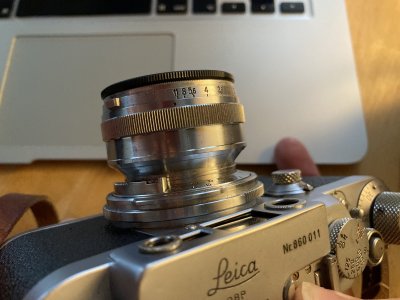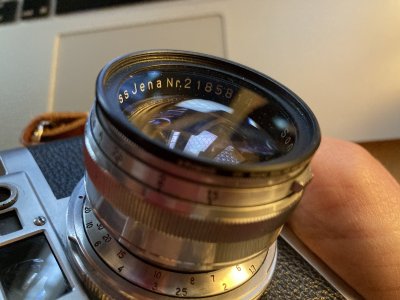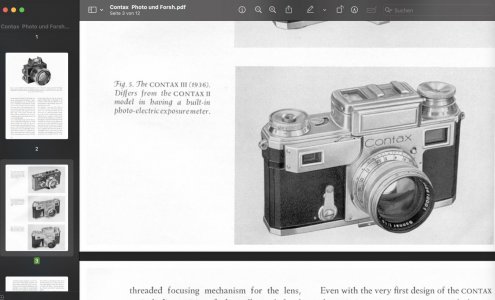dexdog
Mentor
I recently acquired a really nice 5cm f1.5 Sonnar (one of a batch of 3000 completed December 1937). All lens surfaces that I can see by removing the front element and rear group are coated, even though the lens is not "T" marked on the name ring. I noticed that the aperture ring is only marked to f11, but the iris will stop down to what appears to be f16. The booklet by John Keesing called "Contax Rangefinder Lenses 1932-1962" says that CZJ started marking minimum apertures of f16 in 1935 with the production of the chrome and nickel lenses with a black band below the focusing ring. I have not seen much documentation of when CZJ made the switch. Thoughts? Was Zeiss just using up old parts?




Pioneer
Mentor
I have had both and, like you said, the one I owned would close down further but it wasn't marked.
I rarely use my Sonnars closed down that far anyway, My typical aperture setting seems to be 8 or wider. This was the camera I was using when I fell in love with Efke KB25 film. I use a lot of Adox CMS 20 with this lens now.
I have always felt that these lenses were really made for a time when ISO200 was a very fast film. They were never intended for Kodak TriX or Ilford HP5 Plus.
I rarely use my Sonnars closed down that far anyway, My typical aperture setting seems to be 8 or wider. This was the camera I was using when I fell in love with Efke KB25 film. I use a lot of Adox CMS 20 with this lens now.
I have always felt that these lenses were really made for a time when ISO200 was a very fast film. They were never intended for Kodak TriX or Ilford HP5 Plus.
Coldkennels
Barnack-toting Brit.
dexdog
Mentor
Yep, same batch, serial numbers started at 2185801
Räuber
Established
The statement from the book is wrong. Sorry to say this but he made a mistake. I saw this statement online in the past and it caused a lot of confusion when I started investigating the Sonnar 5cm f1,5. There are no Sonnar 5cm f1,5 lenses that have a max aperture of F16 engraved at the aperture scale. The scale only shows F11 but the aperture ring moves to F16.
Please have a look at my overview.
Zeiss Oberkochen started to manufacture Sonnar 50mm f1,5 Contax Range Finder lenses after WWII. The misinterpretation might be caused because Zeiss Oberkochen restarted the serial numbering. So there are lenses in the 1.3M - 1.9M range from before and after WWII.
Another cause might be the Sonnar 5cm f2. There are black Nickel Sonnars with max f16 engraved. But even then the black band f2 Sonnar has an engraved max aperture of f22. Have a look at Pacific Rim for both examples of f2 Sonnars.
Please have a look at my overview.
Zeiss Oberkochen started to manufacture Sonnar 50mm f1,5 Contax Range Finder lenses after WWII. The misinterpretation might be caused because Zeiss Oberkochen restarted the serial numbering. So there are lenses in the 1.3M - 1.9M range from before and after WWII.
Another cause might be the Sonnar 5cm f2. There are black Nickel Sonnars with max f16 engraved. But even then the black band f2 Sonnar has an engraved max aperture of f22. Have a look at Pacific Rim for both examples of f2 Sonnars.
Last edited:
Räuber
Established
Just checked how far the aperture ring of my Chrome Sonnars 5cm F1,5 can be moved and here are the results.
1607140 -> f11
1661030 -> f11
1754317 -> f11
1826639 -> f11
2134948 -> f16
2135127 -> f11
2395317 T -> f16
1607140 -> f11
1661030 -> f11
1754317 -> f11
1826639 -> f11
2134948 -> f16
2135127 -> f11
2395317 T -> f16
dexdog
Mentor
Räuber
Established
The statement from John Keesing is that the marking minimum apertures of f16 [started] in 1935 with the production of the chrome and nickel lenses. It is about the question was there a Sonnar 5cm f/1,5 where the aperture scale ended at a engraved value of f16 before the end of WWII. And no, there are only Sonnars where the aperture scale ended at f8, (f9,5), f11 or f22. So all Chrome Sonnar 5cm f/1,5 have either a scale that ends at f/11 or f/22. There are however Sonnars where you can turn the aperture ring to f/16 (not engraved). The earlier ones can not do this. But there are later ones that are engraved with f/11 that can be turned to f/16. It seems to be no mistake or play of the aperture ring. This was done on purpose by Zeiss.
dexdog
Mentor
Rauber, thanks for the clarification!
Last edited:
None of my Sonnars up to 255xxxx are engraved past F11, but the later lenses have an unmarked F16. My 190xxxx lenses through to my 1607xxx lenses are engraved to F11 and stop at F11. The next I have are from the 267xxxx batch- and engraved to F22, and are alloy. These also have hidden set screws for the namering and rear fixture.
Pioneer
Mentor
The one I have been using is actually a Zeiss-Opton so is post war. It does end with f/16The statement from John Keesing is that the marking minimum apertures of f16 [started] in 1935 with the production of the chrome and nickel lenses. It is about the question was there a Sonnar 5cm f/1,5 where the aperture scale ended at a engraved value of f16 before the end of WWII. And no, there are only Sonnars where the aperture scale ended at f8, (f9,5), f11 or f22. So all Chrome Sonnar 5cm f/1,5 have either a scale that ends at f/11 or f/22. There are however Sonnars where you can turn the aperture ring to f/16 (not engraved). The earlier ones can not do this. But there are later ones that are engraved with f/11 that can be turned to f/16. It seems to be no mistake or play of the aperture ring. This was done on purpose by Zeiss.
Cascadilla
Well-known
My 5 cm f/1.5 Sonnar has a prefix of 213 and stops just a hair past f/11, which is the lowest f/stop marked on the barrel. It is uncoated. My post war Carl Zeiss 50 mm f/1.5 has a prefix of 116 and a hard stop at the marked f/16, the lowest stop marked.
Räuber
Established



2395317 T, 2135127, 2134948, 1826639, 1754317, 1661030, 1607140 -> Oldest lens on the right, newest lens on the left, the serial rises from right to left
I noticed something with my 2135127 and 2134948 pair. Both are from the same batch.
2134948 aperture ring moves past f11
2135127 aperture ring moves past f1,5
I would interpret it as that both lenses reach f16 but the aperture ring of 2135127 is not aligned correctly. So the aperture ring has been changed in this batch (37th) already. So from my list I would say they changed it after batch 28 and at least in batch 37.
Back to the original question from @dexdog. Why this change? Well I can not answer this with 100% certainty.
It is not the first time Zeiss did this. They did a similar thing in batch 6 (starting 1415701). In batch 6 they started with lenses that where engraved with max f8 and could only move to f8. Within 300 copies they changed it to engraved f8 and move to f9,5 and then engraved an unlabeled f9,5 line and move to f9,5. The reason for what happened in batch 6 was that this batch already uses the Berteles second optical calculation (v2). The first calculation (v1) only allowed f8 as maximum aperture. The second calculation (v2) is used later with a max aperture of f11. I would interpret it like that the department building the barrel had no idea of this change and just used the old barrel design until someone mentioned the mistake and they just changed the movement of the aperture ring to correct for it and later put a small line as an indicator of the new max aperture at the lens. Even this is highly debatable because it is still unclear if those lenses really use the second or the first optical calculation.
So why does Zeiss change the aperture ring of the Sonnar 5cm F1,5 to reach f16? Well maybe it is the same story. Bertele created a third optical calculation (v3) in 1935. In theory batch 28 is the first one that uses the third optical calculation. In theory because that is what is written down in Mr. Thieles Fabrikationsbuch. In reality I have doubts about this. I have not written about this yet but I doubt that Berteles second calculation was used in batch 26 and 27. And that is the reason why I have Sonnars from batches 26, 27 and 28. But this aside the answer to your question might be in a little detail most people will not notice. The barrel of the Sonnar 5cm f/1,5 has been changed in batch 33. It is only the mounting part that has been changed cosmetically but this might be the point where they also changed the aperture ring. So in combination with Bertele's 3rd optical design (that allowed a new max aperture of f16) they lightly changed the barrel design and the movement of the aperture ring. Sounds plausible but needs confirmation.
Why did they not engrave a f16 at the aperture scale? Maybe because they did not felt confident about the usability of f16? We can only speculate. I doubt that it is because of spare parts. It would be easy to just engrave an additional number at the scale. So the reason is that they did not want to engrave the f16 at the lens.
JakobN
JakobN
The scale on lens 2610001 ends at 22 but smallest aperture is around 32.
Share:
-
This site uses cookies to help personalise content, tailor your experience and to keep you logged in if you register.
By continuing to use this site, you are consenting to our use of cookies.






